Do you often struggle with sending customer satisfaction surveys that hit the mark and get responses?
Perhaps the solution is to formulate the questions in a way that will help your respondents share their thoughts and provide the insights you need.
In this blog post, we will present seven different customer satisfaction survey email types that really do the job. We will also provide you with some handy templates that you can use today to collect customer feedback from your user base.
Why use a customer satisfaction survey email template?
Customer satisfaction survey email templates help you simplify the feedback process without compromising on quality or consistency. They ensure your emails are clear, on-brand, and sent at just the right moment, so you can focus more on analyzing results than drafting messages from scratch.
Here’s what makes survey email templates especially effective:
- They boost response rates
Templates with embedded survey questions make it easier for customers to reply—no extra clicks, no confusion. - They uncover actionable insights
With well-timed and well-structured templates, you gather meaningful feedback that helps improve products, services, and the overall experience. - They support customer loyalty and retention
By regularly asking for input, you show customers that their voice matters. This leads to better relationships and stronger engagement over time.
But that’s not all. Using a customer feedback survey to gather opinions can help you
- Identify areas of your business that need improvement
Understanding what your clients think about your company helps you implement changes. Measuring the customer experience will then reveal whether the changes you make improve your service. - Spot customer pain points
Learning what clients don't like about your business or website helps you to improve user experience and move visitors down the sales funnel more easily. - Conduct market research
Customer satisfaction surveys can provide valuable insights into what your target audience wants and needs, which you can use to create more targeted advertising campaigns.

Now that we've discussed the benefits of using customer satisfaction surveys, below are seven different email templates you can customize according to your needs.
How to create an effective survey email template
An effective survey email template guides the reader toward action. Every element, from the subject line to the call-to-action, affects whether your message gets opened, read, and answered.
Here’s what to focus on:
Compelling subject line
That's where you capture attention, and it's basically your only chance to get your customer to click on the survey email.
“Studies recommend limiting the total number of characters in a subject line to between 30 and 50.”
Source Limewire
Additionally, we recommend supporting the subject line with an email preheader. It's usually 50 to 100 characters long, grey text that follows the subject line, which may help you convince your recipient to open the feedback request email.
Clear call-to-action
Use direct, benefit-oriented language like “Rate your experience” or “Share your feedback.”
Embedded survey link
To get the best response rates, use the survey link more effectively, for example, embed it directly into the email body. This way, you reduce the number of clicks and have the best chances of getting your first question answered. So, remember to add the most important one at the beginning.
An excerpt from the Survicate's In-Sight newsletter
After the person chooses the desired response, they will be redirected to the survey link, with the remaining questions.
💡Tip: Make sure your customer feedback tool collects partial responses, as some respondents may drop out after the first question.

Brief and focused copy
Respect your reader’s time. Be friendly but concise. Most people skim, so make your message easy to follow.
It also refers to the survey template itself. Emily Stevens from UX Design Institute advises,
“Keep your survey short (and include a progress bar) to avoid drop‑off.” [Source]
In her research, Janet Salmons, Research Community Manager for SAGE Methodspace, confirms that
“Any effort to reduce the length of a survey will often produce better data because participants will be more likely to focus on the questions.” [Source]
Personalization
Include details like the customer’s name, the product they used, or a recent interaction. Small touches can increase relevance and trust.
Optional visual support
Add a product image or small icon if it helps clarify the message. Just don’t overload the design.
Compare the 7 types of satisfaction survey email templates
Each customer satisfaction survey template fits a specific point in the customer journey, from first impressions to long-term retention. It helps track customer satisfaction levels from different angles to get a more global view of how clients feel about your product/service.
Here’s a breakdown of the seven key types, including when to send them and what they’re designed to uncover.
💡 Tip: Use this comparison table when planning automated email flows. Matching the right feedback request email template to the right moment increases both your response rate and the quality of insights.
Net Promoter Score (NPS) email template
Sending Net Promoter Score emails
This key performance indicator (KPI) is widely used to gauge customer satisfaction and loyalty by measuring how likely your clients are to recommend your business to others, typically on a 1-10 rating scale.
Your most keen promoters (those giving the highest ratings) can become customer advocates or potential brand ambassadors. This can be an invaluable asset for your business, as customer referrals are often the most powerful form of marketing.
An is short and sweet, so keep your email template succinct, too. You'll get a lot of helpful replies through surveys so you can make more data-driven decisions.
There are many appropriate places for storytelling, but NPS email templates are not one of them. A one-sentence intro to add some context (e.g., a recent purchase or onboarding), your question, an interactive scale to click through, and a genuine “thank you” will be enough.
When to send it
7–14 days after a customer completes a purchase, finishes onboarding, or reaches a key milestone.
For example, Pranamat, a premium acupressure mats manufacturer, sends the NPS survey 15 days after a purchase, and uses it for the ambassadors program.
What it measures
Loyalty and referral likelihood, typically measured on a 0–10 scale.
Survicate's Net Promoter Score email template
Subject: How likely are you to recommend us?
Hi [First Name],
Thanks again for choosing [Company/Product]. We’d really appreciate your feedback on one quick question:
How likely are you to recommend us to a friend or colleague?
Just click a number from 0 to 10 below:
[0–10 scale]
Your response helps us understand what’s working and what needs attention.
Thanks for your time,
[Your Name]

Best practices for sending an NPS survey
- Keep it brief. A single sentence of context + one question is enough.
- Add an optional comment field after the scale to gather deeper insights.
- Use responses to identify potential brand advocates or users at risk of churn.
Real-world Net Promoter Score email template
Squarespace asking their customers to fill out an NPS survey.

Customer Satisfaction Score (CSAT) template
Sending Customer Satisfaction Score (CSAT) emails
This KPI can be used to quickly check how a client is getting on with a recent purchase through a one-click feedback button. Their CSAT score will either let you know they are happy or allow you to identify any potential issues early on.
You should aim to send a customer satisfaction product survey as soon as possible after a customer has made a purchase and received their item or used your service. This way, their impression will still be fresh in their mind.
This kind of customer feedback can be very useful when creating buyer personas, as it helps you get to know your clients better and tailor your future messaging and recommendations to their preferences.
When to send it
24–48 hours after product delivery or customer service engagement.
What it measures
Immediate satisfaction with a product, service, or specific touchpoint.
For example, Hitta.se uses CSAT surveys to measure satisfaction after clients interact with the customer-facing teams.
We use CSAT surveys to evaluate our agents. We measure CSAT when customers report issues. So, they will evaluate the agent handling the specific problem. We also do it for the Sales team—when they make a deal, we would like the customer to tell us "how satisfied are you with our sales representatives?"
Alice Samuelsson, Product Manager at Hitta
Survicate's product/service satisfaction email template
Subject: How satisfied are you with your recent experience?
Hi [First Name],
We hope you're enjoying your [product/service] from [Company Name].
Would you mind telling us how satisfied you are with your experience?
Please click the option that best reflects your opinion:
[Extremely Dissatisfied | Somewhat Dissatisfied | Neutral | Somewhat Satisfied | Extremely Satisfied]
Thanks for helping us make things better.
Best regards,
[Employee’s Name]
[Position] at [Company Name]
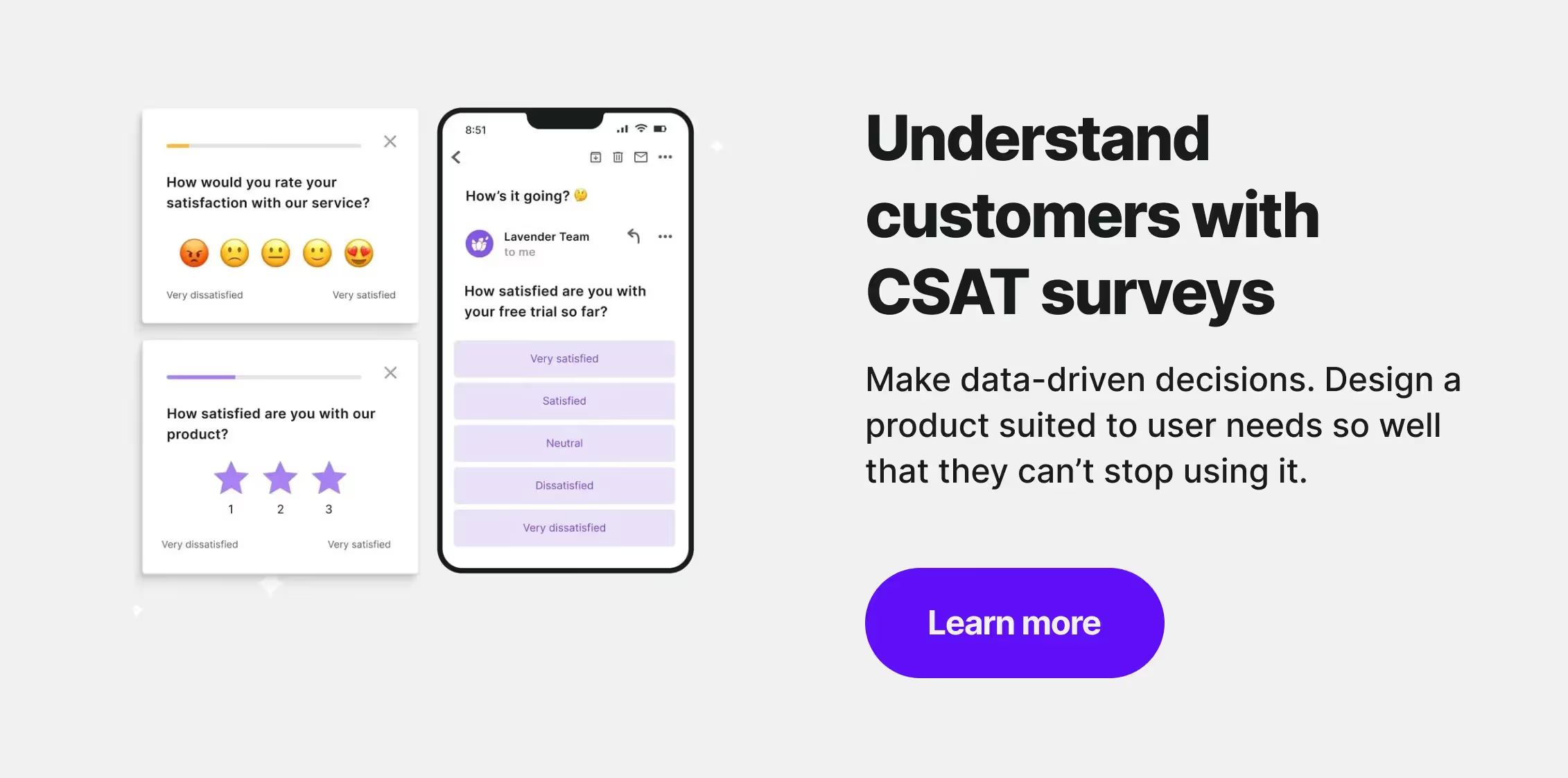
Best practices for sending a CSAT survey
- Use a one-click scale to reduce friction and increase response rates.
- Follow up with an open-text question for added context.
- Integrate CSAT data into your CRM to personalize future touchpoints.
Real-world product/service satisfaction email template

Customer service email template
Sending customer service satisfaction (CSS) emails
You can use customer service survey emails to determine a CSS score, which assesses your customer's opinion of the experience when contacting your company's support team.
This metric is similar to the CSAT score. The difference is that it measures satisfaction with a customer service experience instead of a product or service.
Remember to send customer service emails as quickly as possible after a user contacts support so that their opinion is still fresh in their memory. You can use a quick one-click rating button to encourage responses.
However, it can be more insightful to include a link to a survey where users can leave more detailed observations. This is particularly important in the case of a poor customer service experience, as you want to learn from it.
When to send it
Immediately after a support ticket is closed or a live chat ends.
ParkBee’s Customer Service Manager, Louise Alberg shares:
We always ask for feedback after every parking session. As soon as a parking action has been completed, we will send out a survey to ask about the recent experience of the parker.
What it measures
Satisfaction with the customer service experience—speed, clarity, and helpfulness.
Survicate's customer service email template
Subject line: How was your experience with our support team?
Hi [First Name],
Thanks for contacting [Company Name] Support. We hope we resolved your issue effectively.
Could you take a moment to let us know how we did?
Please rate your experience:
[1 – Poor | 2 – Fair | 3 – Okay | 4 – Good | 5 – Excellent]
Your feedback helps us keep our service fast, helpful, and consistent.
Best regards,
The [Company Name] Support Team
Best practices
- Send the survey while the interaction is still fresh.
- Keep it short, one question is often enough.
- Look for patterns in low scores to spot training or process gaps.
Real-world customer service email templates


Customer Effort Score (CES) template
Sending Customer Effort Score (CES) emails
Customer Effort Score evaluates how much work was required for users to complete an action or find information. For example, completing an order, asking for a refund, getting in touch with customer support or something else.
It's best to send a CES survey email after the customer has made a purchase or subscribed to a service. This will give them the opportunity to fully test the product before giving feedback.
When to send it
Shortly after the customer finishes a key task or interaction, typically within 1–3 days.
What it measures
Perceived effort required to complete a process, task, or action.
Wellhub uses it a lot while assessing new features:
Whenever we launch a new feature, we often include a CES survey to check if users find it intuitive. If scores are low, we know we need to make adjustments. - Bruna Maia, Director of User Experience at Wellhub
Survicate's Customer Effort Score email template
Subject: Was this easy for you?
Hi [First Name],
Thanks for using [Product/Service Name].
We’re always looking to make things smoother. Could you tell us how easy it was to get things done?
[Very Difficult | Somewhat Difficult | Neutral | Somewhat Easy | Very Easy]
If you have suggestions on how we can improve, feel free to reply to this email—we’re listening.
Best,
[Your Name]
Customer Experience Team at [Company Name]
Best practices
- Focus the question on ease, not satisfaction.
- Send the survey soon after the user completes the action.
- Use results to reduce friction in your product or service flow.
Real-world Customer Effort Score email template

Customer Health Score email template
Sending Customer Health Score emails
Customer Health Score is a measure of customer engagement and retention. This type of customer satisfaction email aims to gain insights into customers' behavior over time and determine whether they will stay with your business or churn.
Various factors contribute to determining a customer's health score, and the measurement system will vary from company to company. That being said, one important aspect is their willingness to take part in surveys.
It's best to send a customer health score email after a particular customer hasn't shopped with you lately or if their subscription period is soon ending. This will give you the opportunity to analyze their likelihood of churning before they do so.
What if you categorize customers' health as “at risk” because they appear to be on the verge of churning? The next step would be to send them a win-back email to get feedback, possibly including discounts or offers.
When to send it
During mid-subscription, near renewal, or after signs of reduced activity.
What it measures
Product adoption, usage frequency, and overall engagement health.
Survicate's Customer Health Score email template
Subject: Quick check-in: How are things going?
Hi [First Name],
We’d love to hear how things are going with [Product/Service Name]. Your feedback helps us ensure you’re getting the most out of your experience.
Please take a moment to answer a few quick questions.
[Start Survey Button]
We’re curious about:
- How often do you use [Product]?
- Your favorite features
- Anything that could work better
Thanks for your time,
[Customer Success Team Name]
[Company Name]
Best practices
- Use this survey to flag accounts that may need support or outreach.
- Keep questions short and behavior-focused.
- Segment users based on their responses to personalize retention efforts.
Real-world Customer Health Score email template

Customer churn / win-back survey email template
This customer satisfaction survey template helps you understand why users stopped engaging and gives you a chance to reconnect.
Customer churn rate calculates how many users cancel their subscriptions or don't renew it in a given period. To minimize customer churn, you should look to identify pain points through a customer satisfaction email, such as the win-back message above.
This has the dual purpose of gathering valuable feedback from a presumably dissatisfied customer and giving you the opportunity to repair the relationship.
If a customer has experienced an issue with your product, they may appreciate being given the opportunity to reply to an email or fill out a survey and provide feedback.
You can also prompt existing clients to make a repeat purchase with a renewal reminder email template
When to send it
30–90 days after inactivity, subscription cancellation, or missed renewals.
What it measures
Reasons for churn, potential blockers, and willingness to re-engage.
Sample email
Subject: We’d love to hear from you
Hi [First Name],
We noticed you haven’t been using [Product/Service Name] lately, and we’d really appreciate your feedback.
Is there anything we could’ve done better? Your input helps us improve—and maybe even make things right.
[Take the Survey Button]
Thanks for being part of our journey,
[Your Name]
Customer Success Team at [Company Name]
Best practices
- Keep the tone empathetic and open, don’t push for reactivation immediately.
- Include a simple survey and an optional comment field.
- Consider offering a small incentive or reminder of unused benefits.

Customer review request email template
While not a metric per se, reviews are still a reliable measure of customer satisfaction and one that consumers actually pay a great amount of attention to.
They can showcase good customer experiences and build trust with consumers.
In fact, according to a recent survey, 79% of people trust customer reviews as much as either personal recommendations from friends and family, social media personalities, or professionally written articles by topic experts.
You can collect online reviews through emails that request specific feedback about, for example, a recent purchase. Or, you could also ask the recipient to leave their rating and opinion on an external website, such as the App Store.
Use this survey email template to collect public reviews or testimonials from satisfied customers, building trust and credibility with future buyers.
When to send it
Shortly after a successful delivery, onboarding, or positive interaction.
What it measures
Willingness to share feedback publicly and perceived satisfaction with the overall experience.
Sample email
Subject: Share your thoughts?
Hi [First Name],
We hope you’re enjoying your experience with [Product/Service Name]. If you have a moment, we’d love for you to leave us a quick review.
[Leave a Review Button]
Your feedback helps others make confident decisions and helps us keep improving.
Want us to feature your review on our site? Just let us know.
Thanks again for being part of the [Company Name] community,
[Your Name]
Customer Team at [Company Name]
Best practices
- Time it right, send after a confirmed success moment.
- Make the review process as effortless as possible (one click is ideal).
- Use strong reviews in testimonials, case studies, and product pages.

How to improve your survey email templates?
Even the best email template can underperform without the right execution. These practical tips will help you get more responses, better data, and higher engagement from every customer survey email you send.
Personalize your message
Use the customer’s name, recent action, or purchase details. A little context makes your request feel more relevant and less like a mass blast.
💡Tip: For example, with Survicate, you can enrich questions with the CRM information (ex. HubSpot)
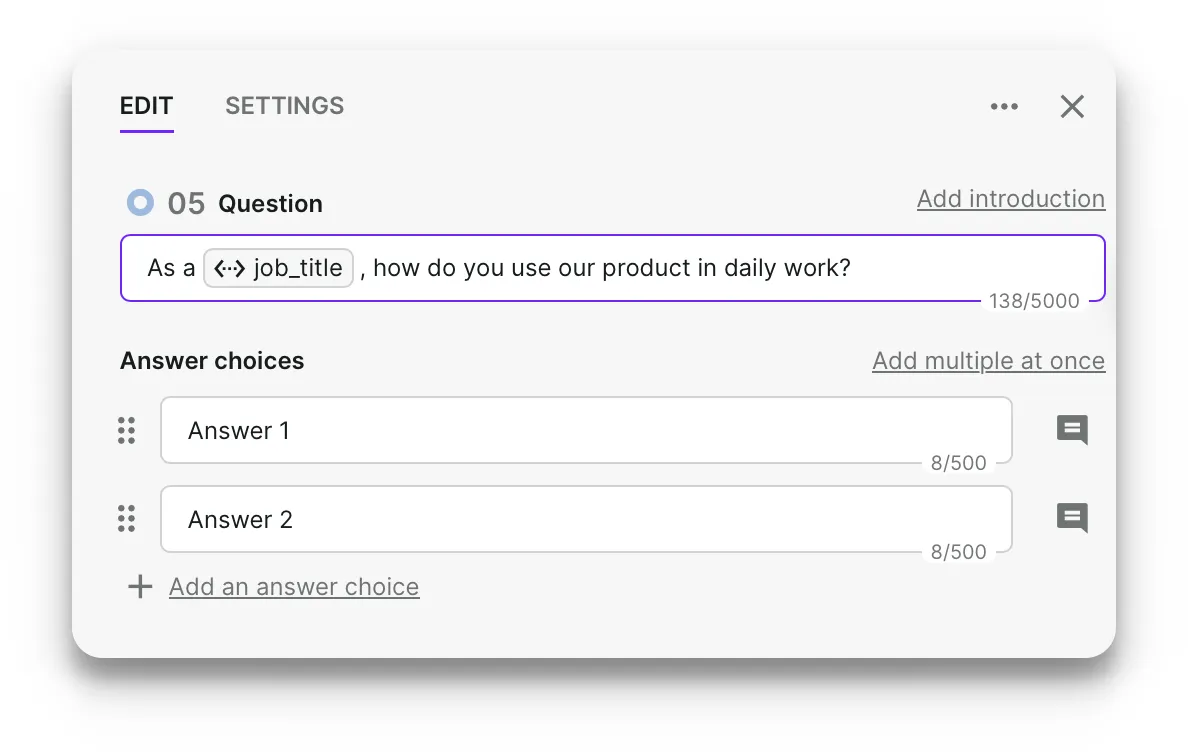
Keep it short and focused
Stick to one main question per email. Avoid overexplaining or adding unrelated calls to action. The clearer the ask, the higher the response rate.
Use one-click feedback tools
Embed your first survey question directly into the email body. This eliminates extra steps and significantly improves completion rates.
Follow up with non-respondents
A reminder 2–3 days later can boost response rates by up to 40%. Try a different subject line or send time to catch attention.
Use survey email templates to boost feedback and retention
Customer satisfaction email templates are a key tool customer success teams have at their disposal to measure the happiness and loyalty of their clients.
Leveraging feedback surveys and customer satisfaction metrics helps you to develop actionable insights that inform decisions about product improvements, customer support strategies, marketing tactics, and more.
Adding customer satisfaction email templates to your strategy is a great way to keep your clients happy with your services. In turn, this can lead to greater customer retention rates and long-term customer loyalty.
Want to make it even easier?
Try Survicate free for 10 days. You’ll get access to one-click surveys, automation features, and advanced analytics designed to help you close the feedback loop faster.
Customer satisfaction survey templates FAQs
1. What is a customer satisfaction survey email template?
A customer satisfaction survey email template is a pre-written message designed to collect feedback from customers. It typically includes a short intro, a clear question (or link to a survey), and a call to action, making it easy for recipients to respond.
2. When should I send a survey email to a customer?
It depends on the feedback you want:
- CSAT: Right after product delivery or support interaction
- NPS: 7–14 days after onboarding or purchase
- CES: After the user completes a key task
- Churn/Win-Back: 30–90 days after inactivity
Timing is key - send when the experience is still fresh.
3. What’s the difference between CSAT, NPS, and CES?
- CSAT (Customer Satisfaction Score): Measures how happy customers are with a specific interaction.
- NPS (Net Promoter Score): Gauges overall loyalty by asking how likely a customer is to recommend you.
- CES (Customer Effort Score): Assesses how easy it was to complete an action (like checkout or onboarding).
Each one tells a different part of the customer story.
4. How can I increase response rates to survey emails?
- Personalize the email with the name or recent activity
- Embed the first question directly in the email
- Keep your message short and focused
- Follow up after a few days if there’s no reply
Less friction = more feedback.
5. What’s the best tool to send survey emails?
Survicate is a great choice. It lets you:
- Embed surveys directly in emails (no extra clicks)
- Automate follow-ups based on customer actions
- Track partial responses
- Integrate with tools like HubSpot, Intercom, and Mailchimp
Ideal for CSAT, NPS, CES, and more - all in one platform.
6. Can I automate customer satisfaction survey emails?
Yes, most CRMs and email platforms (like HubSpot, Klaviyo, or Intercom) support automated workflows triggered by events such as purchases, support case closures, or user inactivity.
Survicate integrates with these tools and allows you to build automation that sends the right survey at the right time.
7. What are the best call-to-actions (CTAs) to get survey responses?
Effective CTAs are clear, action-oriented, and set the right expectation. Here are a few that consistently perform well:
- “Take the survey” - Simple and direct
- “Share your feedback” - Signals value and involvement
- “Tell us what you think” - Friendly and conversational
- “Rate your experience” - Best for CSAT or CES surveys
- “Answer one quick question” - Emphasizes minimal time required
- “Help us improve” - Appeals to users who want to make things better
💡 Pro tip: Keep your CTA button visible and uncluttered, ideally placed above the fold or right after the key message.
What are the best starting phrases for a survey email?
The first line of your survey email sets the tone and decides whether the reader continues. Here are high-performing openers that strike the right balance of friendly and purposeful:
- “We’d love your feedback on your recent experience.”
- “Quick question: can you help us improve?”
- “Thanks for choosing [Company Name]. Mind sharing your thoughts?
- “Your opinion helps us get better: can we ask a favor?”
- “Just a moment of your time for one quick question.”
- “We’re always looking to improve. Tell us how we did.”
💡 Keep it human, relevant, and brief. The more natural it sounds, the more likely your customer is to engage.








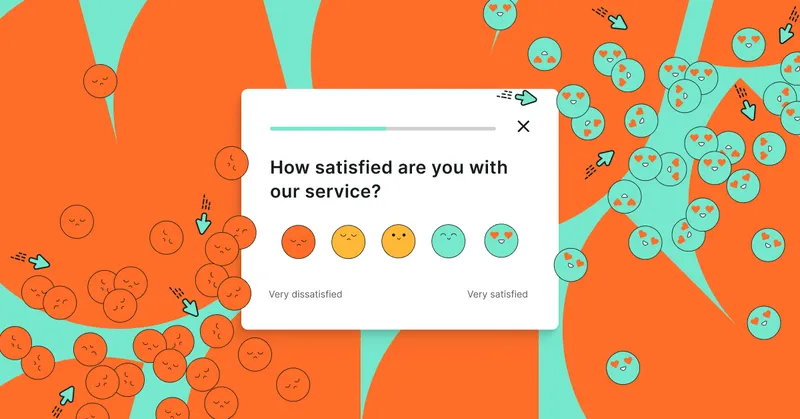
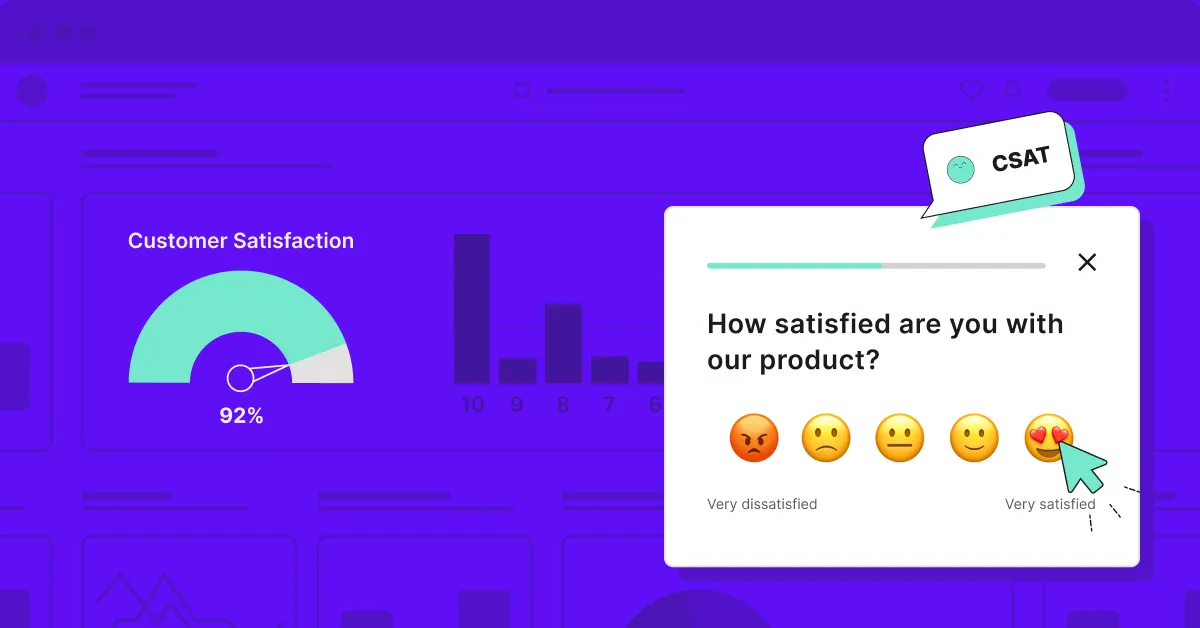
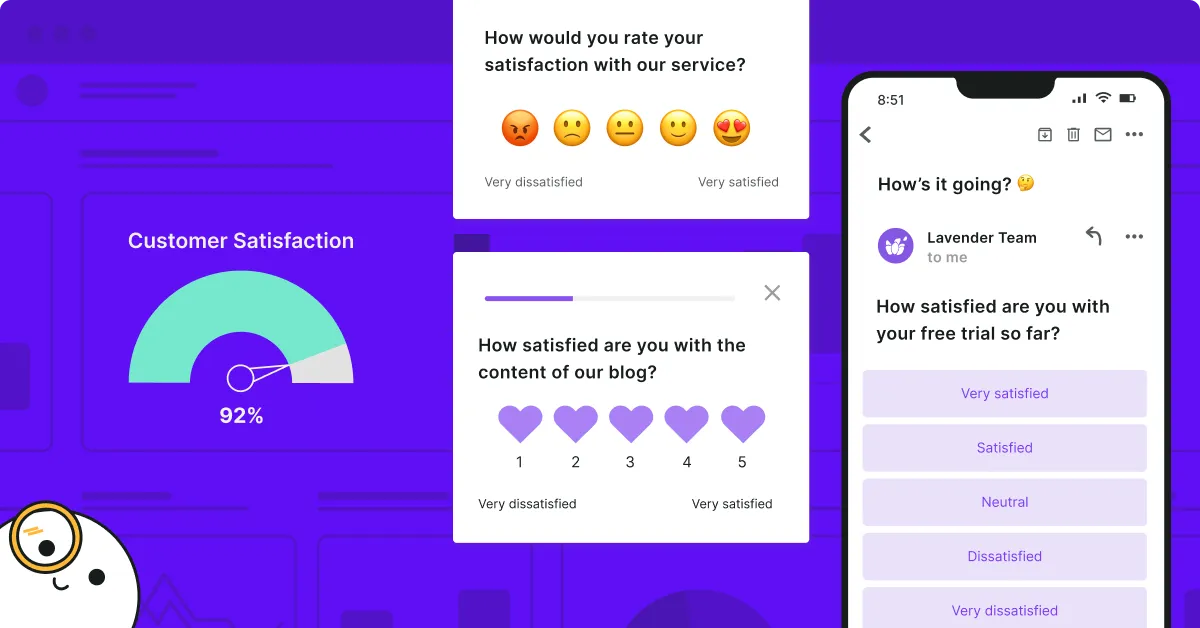
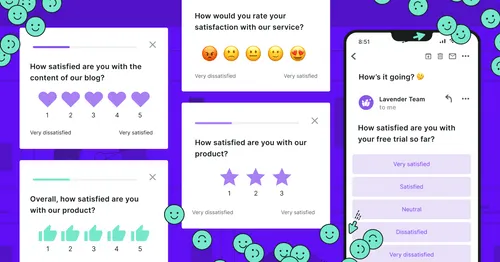
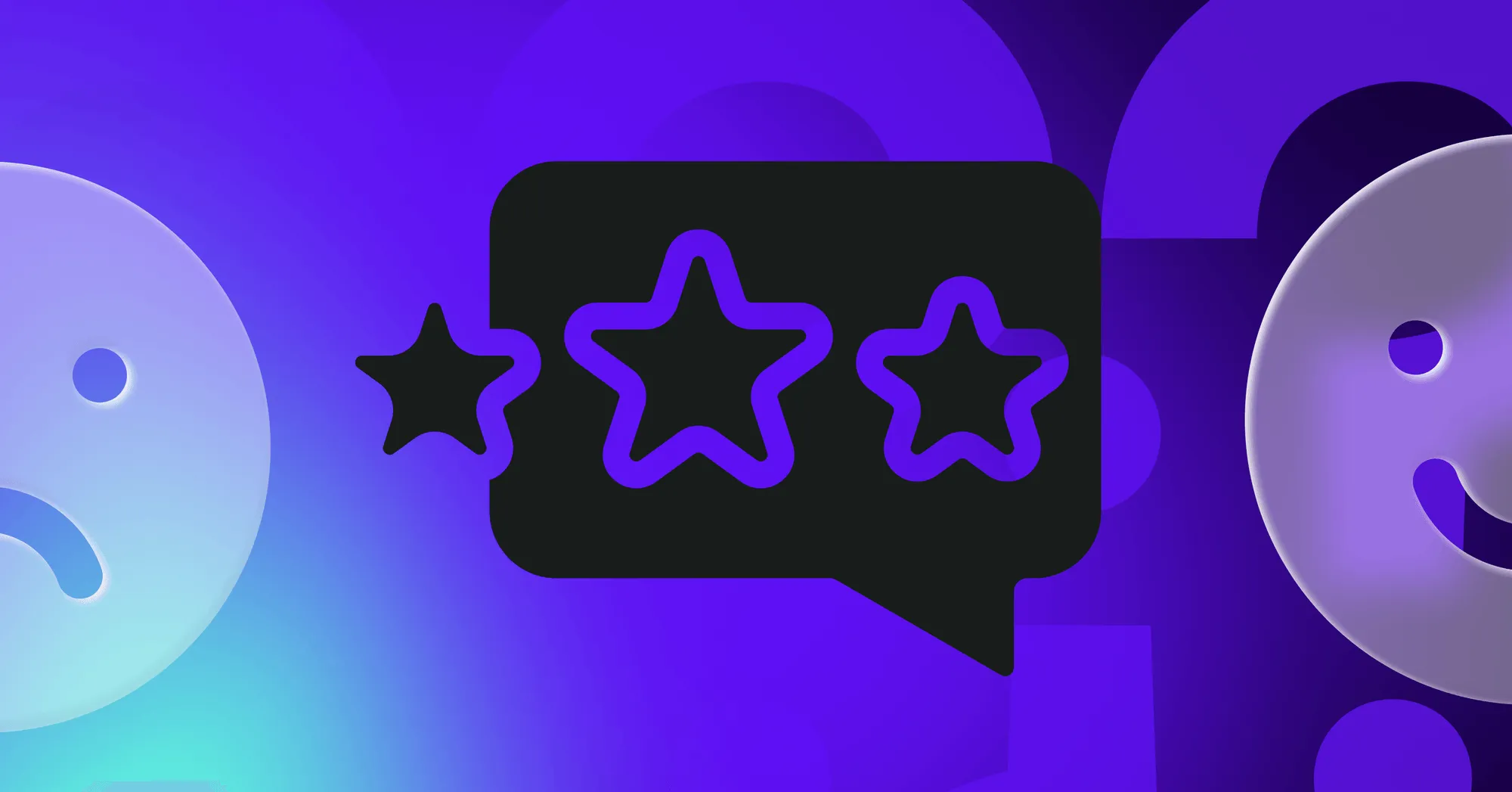
.svg)

.svg)



